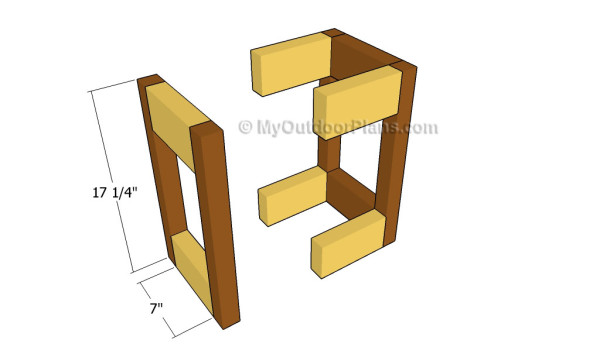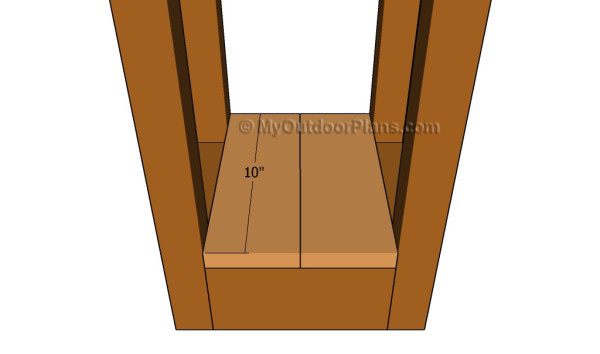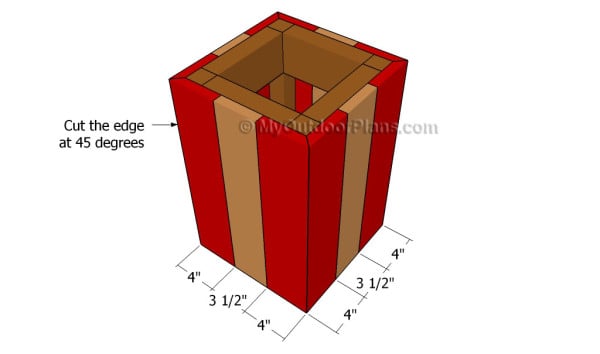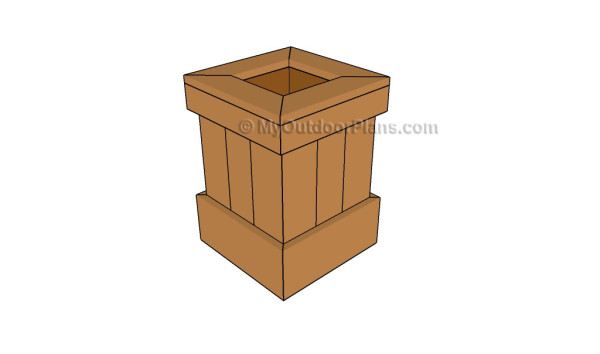This step by step diy woodworking project is about planter box plans. If you want to learn more about building a simple planter box, we recommend you to pay attention to the instructions described in the article. There are many sizes, designs and materials to choose from when building a planter box, so make sure you pay attention to the rest of the planter plans featured on our website.
It is essential to invest in high-quality materials, such as pine, cedar or redwood, as the planter will be exposed to bad weather and excessive sunlight. Make sure you select the slats with great care, as they should be in a good condition and perfectly straight. Check if the corners are right-angled before inserting the screws, otherwise the planter box won’t have a symmetrical appearance. See all my Premium Plans HERE.
Projects made from these plans
Planter Box Plans

Building a planter box
Cut & Shopping Lists
- A – 8 pieces of 2×4 lumber – 7″ long, 4 pieces of 2×2 lumber – 17 1/4″ long FRAME
- B – 8 pieces of 1×6 lumber – 17 1/4″ long, 4 pieces of 1×4 lumber – 17 1/4″ long WALL
- C – 2 pieces of 1×4 – 10″ long BOTTOM
- D – 4 pieces of 1×6 lumber – 13″ long, 4 pieces of 1×3 lumber – 13″ long TRIMS
- E – 4 pieces of 1×4 lumber – 13″ TRIMS
Tools
![]() Hammer, Tape measure, Framing square, Level
Hammer, Tape measure, Framing square, Level
![]() Miter saw, Drill machinery, Screwdriver, Sander
Miter saw, Drill machinery, Screwdriver, Sander
Time
Related
Building a planter box

Building the frame of the planter box
In order to build a planter box, we recommend you to begin with building the main frame. As you can easily notice in the diagram, we recommend you to build the corner components out of 2×2 lumber, while the supports should be made out of 2x4s.
Cut the components after taking accurate measurements and lock the together with galvanized screws. Make sure the corners are right-angled and drill pocket holes at both ends of the supports before inserting the 2 1/2″ screws.

Fitting the bottom slats
Attach the bottom slats to the lower supports, as shown in the image. Cut the slats at the right size and lock them into place with several 1 1/4″ galvanized screws. Make sure you align the components at both ends and you leave no gaps between the slats.

Attaching the exterior slats
Continue the garden project by attaching the slats to the exterior frame of the planter box. As you can easily notice in the diagram, we recommend you to adjust the width of the corners slats at 4″. Moreover, build the center slats from 1×4 lumber and secure them into place with screws.
Leave no gaps between the slats and secure them to the frame with 1 1/4″ screws or finishing nails. Pre-drill the slats to prevent the wood from splitting.

Attaching the trims
Although this step is not compulsory, it will most certainly add value to your planter box. As it can be seen in the image, you need to build the bottom trims out of 1×6 lumber and the top trims out of 1×3 lumber.
Make sure you cut both ends of the trims at 45 degrees, otherwise they won’t lock together properly. Leave no gaps between the components and secure them to the exterior walls with 1 1/4″ finishing nails and glue.

Attaching the top trims
Afterwards, you need to hide the structure of the planter box, by fitting trims to the top of the frame. As you can easily notice in the image, we recommend you to adjust the width of the top trims to 3″, before securing them into place with finishing nails.
Cut both ends of the trims at 45 degrees and leave no gaps between the components. Use a router to round the exposed edges of the trims, if you want to add character to the woodworking project.

Planter box plans
One of the last steps of the woodworking project is to take care of the finishing touches. Therefore, fill the pilot holes with wood putty and smooth the surface with 120-grit sandpaper.
Top Tip: If you want to enhance the look of the woodworking project and to protect the planter box from decay, we recommend you to cover the components with paint or stain. Place the planter in a proper location and move it whenever necessary.
This woodworking project was about planter box plans. If you want to see more outdoor plans, we recommend you to check out the rest of our step by step projects. LIKE us on Facebook and Google + to be the first that gets out latest projects.
